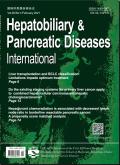Chemokines and PI3K/AKT signaling pathway mediate the spontaneously ruptured hepatocellular carcinoma through the regulation of the cell cycle
IF 4.4
3区 医学
Q2 GASTROENTEROLOGY & HEPATOLOGY
Hepatobiliary & Pancreatic Diseases International
Pub Date : 2025-01-31
DOI:10.1016/j.hbpd.2025.01.003
引用次数: 0
Abstract
Background
The incidence of spontaneously ruptured hepatocellular carcinoma (srHCC) has been shown to significantly elevate mortality rates. However, the precise mechanisms underlying srHCC remain poorly understood.
Methods
Analysis was conducted on the data of 198 hepatocellular carcinoma (HCC) patients to investigate the factors contributing to srHCC. The clinical data of 33 transcriptome HCC patients were served for verification. An in-depth transcriptome analysis was conducted to investigate the distinctions between 26 cases of srHCC and 35 cases of non-ruptured hepatocellular carcinoma (nrHCC). Weighted Gene Co-expression Network Analysis (WGCNA) tool was utilized to develop a gene co-expression network. Gene ontology (GO) and Kyoto encyclopedia of genes and genomes (KEGG) pathways enrichment, and protein-protein interaction (PPI) network were carried out. The corresponding samples for spontaneously ruptured hepatocellular carcinoma tissue (srHCC-T) and ruptured hepatocellular carcinoma paracancerous tissue (srHCC-P) were selected for verification. Transcriptional data were validated through reverse transcription quantitative polymerase chain reaction (RT-qPCR). Immunofluorescence (IF), immunohistochemistry (IHC) and Western blot were used to detect the protein expression.
Results
Our results showed that white blood cell (WBC) and monocyte levels were significant independent risk factors for srHCC (P < 0.05). There was a strong association between the srHCC-T and the expression of cell cycle-related genes BUB1B and macrophage function-related gene MACRO. Furthermore, chemokines and the PI3K/AKT signaling pathway play a crucial role in regulating the cell cycle process through a complex network of interactions, ultimately impacting the occurrence of srHCC.
Conclusions
Our study confirms that chemokines and the PI3K/AKT signaling pathway mediate the occurrence of HCC rupture by regulating the cell cycle. We provide a theoretical basis for the clinical treatment of srHCC.
趋化因子和PI3K/AKT信号通路通过调控细胞周期介导自发性破裂肝癌的发生。
背景:自发性破裂型肝细胞癌(srHCC)的发生率已被证明可显著提高死亡率。然而,srHCC的确切机制仍然知之甚少。方法:对198例肝细胞癌(HCC)患者资料进行分析,探讨诱发srHCC的因素。对33例HCC转录组患者的临床资料进行验证。通过深入的转录组分析,探讨26例srHCC与35例非破裂性肝细胞癌(nrHCC)之间的差异。利用加权基因共表达网络分析(Weighted Gene Co-expression Network Analysis, WGCNA)工具构建基因共表达网络。基因本体(GO)和京都基因与基因组百科全书(KEGG)途径富集,以及蛋白-蛋白相互作用(PPI)网络。选择自发破裂的肝细胞癌组织(srHCC-T)和破裂的肝细胞癌旁组织(srHCC-P)相应的样本进行验证。通过逆转录定量聚合酶链反应(RT-qPCR)验证转录数据。采用免疫荧光(IF)、免疫组化(IHC)和Western blot检测蛋白表达。结果:白细胞(WBC)和单核细胞水平是srHCC的独立危险因素(P < 0.05)。srHCC-T与细胞周期相关基因BUB1B和巨噬细胞功能相关基因MACRO的表达有较强的相关性。此外,趋化因子和PI3K/AKT信号通路通过复杂的相互作用网络在调节细胞周期过程中发挥重要作用,最终影响srHCC的发生。结论:我们的研究证实趋化因子和PI3K/AKT信号通路通过调节细胞周期介导HCC破裂的发生。为srHCC的临床治疗提供理论依据。
本文章由计算机程序翻译,如有差异,请以英文原文为准。
求助全文
约1分钟内获得全文
求助全文
来源期刊
CiteScore
5.40
自引率
6.10%
发文量
152
审稿时长
3.0 months
期刊介绍:
Hepatobiliary & Pancreatic Diseases International (HBPD INT) (ISSN 1499-3872 / CN 33-1391/R) a bimonthly journal published by First Affiliated Hospital, Zhejiang University School of Medicine, China. It publishes peer-reviewed original papers, reviews and editorials concerned with clinical practice and research in the fields of hepatobiliary and pancreatic diseases. Papers cover the medical, surgical, radiological, pathological, biochemical, physiological and historical aspects of the subject areas under the headings Liver, Biliary, Pancreas, Transplantation, Research, Special Reports, Editorials, Review Articles, Brief Communications, Clinical Summary, Clinical Images and Case Reports. It also deals with the basic sciences and experimental work. The journal is abstracted and indexed in SCI-E, IM/MEDLINE, EMBASE/EM, CA, Scopus, ScienceDirect, etc.

 求助内容:
求助内容: 应助结果提醒方式:
应助结果提醒方式:


